I’ve had the privilege of attending not one, but two crawfish boils this year. There were quite a few leftovers at the second one, so I gladly received an offered bag of mudbugs. “You can make an omelet1 with the tail meat in the morning,” one of my hosts suggested. Little did he know I had greater ambitions than breakfast. I knew I had these greater ambitions, I just didn’t know what they specifically were yet.
The next day, I started searching for leftover crawfish recipes. My mind was on something soup or stew related. One blog suggested making crawfish bisque and offered a recipe. This looked interesting, but I knew I was venturing into some murky waters. A lot of people carelessly throw around terms like bisque, etouffee, jambalaya, and gumbo without any respect to what all of those dishes actually are.
To settle the matter, I once again opened the LeBlanc family cookbook. Upon finding Crawfish Bisque in the index, I turned to the recipe, completely unaware of what I was about to see. The ingredients list was broken into two sections and took up more than half a page. The recipe in total was more than two pages long. And then I saw the very first sentence:
“This is a labor-intensive Creole delicacy, best attempted by a team of 2 or more persons.”
Oops. While I wanted to make more than an omelet, I wasn’t prepared to make the Creole equivalent of Peking Duck. I smiled and decided to read on to get some ideas. The next bit was about roux.
“To give the gravy its color, cook the roux until it is dark brown or several shades darker than a paper bag (or see Sherwin Williams paint sample SW 6097 Sturdy Brown).”
I have to admit, I laughed out loud. The last thing I ever expected to find in the family cookbook was a comparison to a paint chip sample. I’ve made attempts at roux before and have generally been pleased with the results, but I confess most of my roux has ended up on the “blond” side. I’m usually going a little too fast, making a bit less than the recipe is calling for, and not wanting to chance scorching it.
I read the rest of the recipe. There were instructions on cleaning the crawfish heads and tails, making gravy, and making stuffing. Then you stuff the heads, serving with the tails and gravy. Voila! A Creole delicacy… and one that would have to wait for another day, at the very least.
Despite being a recipe I really didn’t have the time or ingredients to prepare, it did land me in the right section of the cookbook. Several gumbo recipes followed the one for bisque, so I began reading those to glean some ideas. Then I formulated a strategy and got to work in the kitchen.
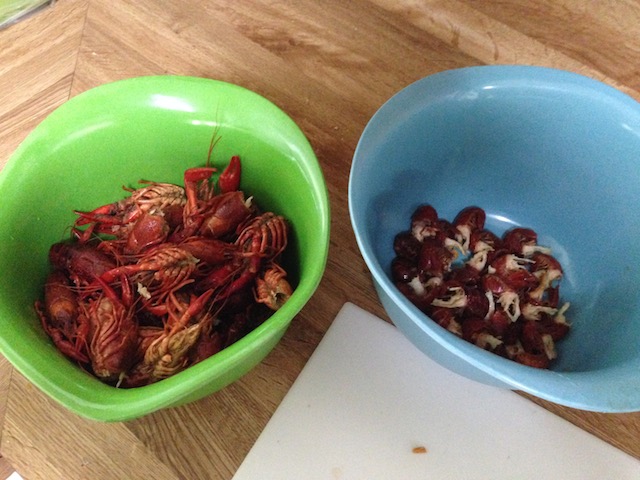
First order of business was to separate the crawfish heads from the tails. Doing this up front made it easier to then go back through and get the meat out of the tails. I then had a small pile of crawfish tail meat ready for my gumbo.
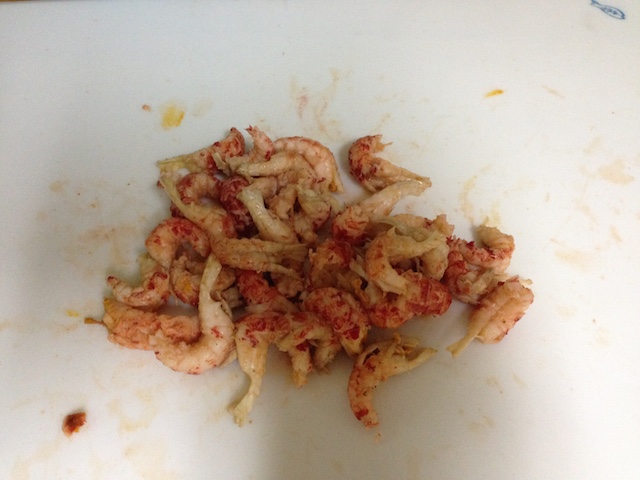
Next, I got my stock pot ready. Along with the crawfish bodies, I threw in some bay leaves, half a lemon, and several stalks of celery. I also measured out about twelve cups of filtered water. All of this went on to simmer while I worked on the rest of the gumbo.

I readied more vegetables. A green bell pepper, more celery, and an onion were chopped and set aside.
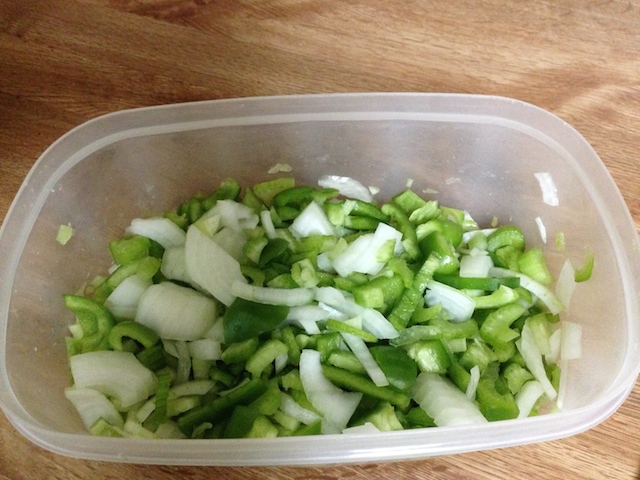
I also chopped up some parsley and green onion to be added towards the end.
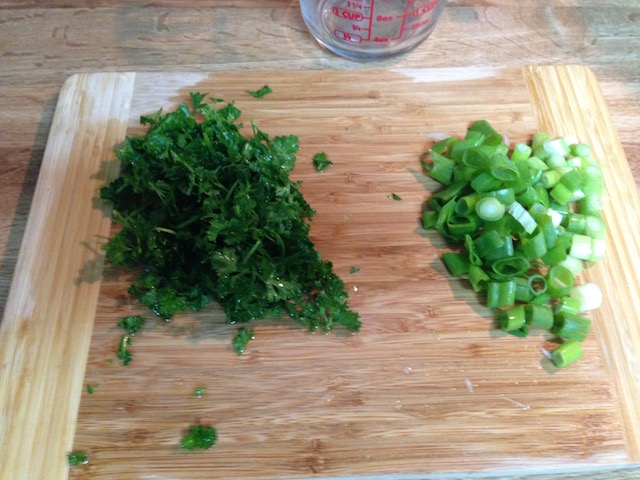
Now my goodie bag from this crawfish boil didn’t include just crawfish: I also received sausage, corn on the cob, and mushrooms. I decided to set aside the mushrooms for the end, because I knew I would be freezing some portions and didn’t want all of them to have mushroom. Mushrooms aside, I began processing the corn and sausage.
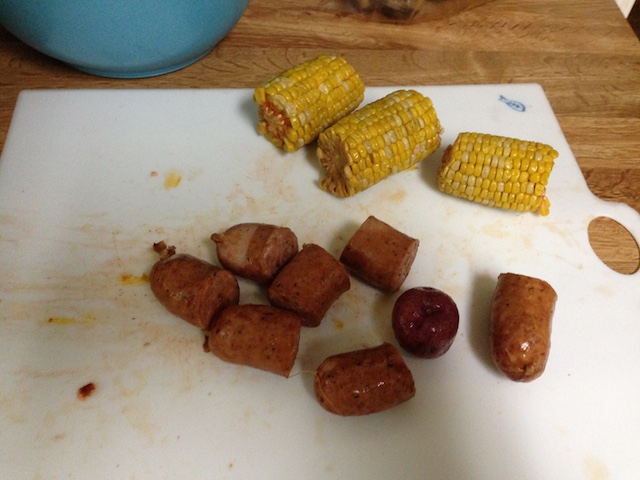
On the first go around, I shaved off all of the corn kernels and sliced the sausage into rounds.
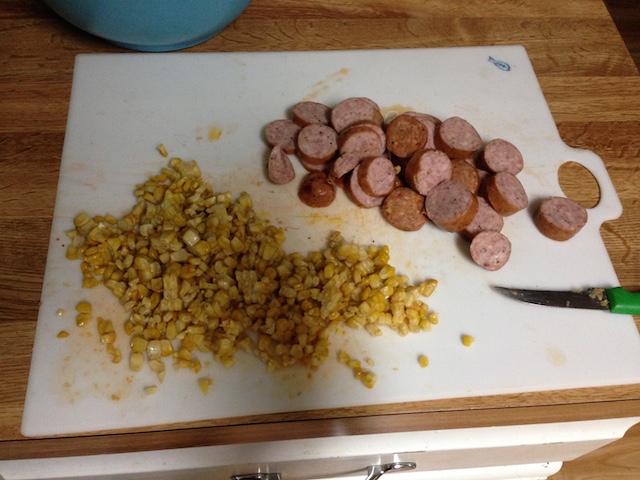
The sausage rounds were a little larger than I wanted, so I chopped them further into little pieces.
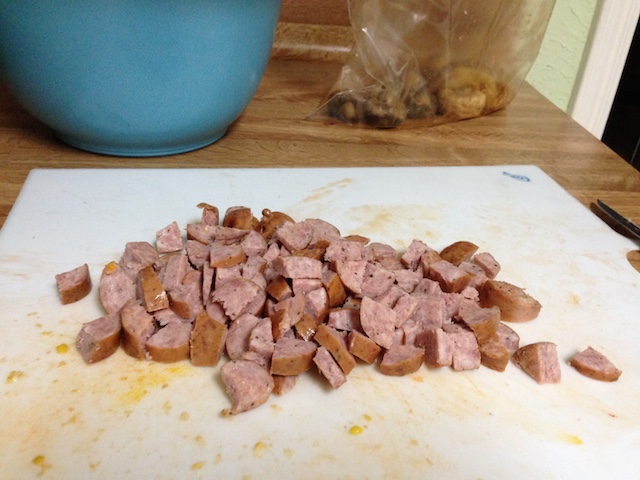
Then I combined all of my pre-boiled ingredients into a bowl and set it aside.
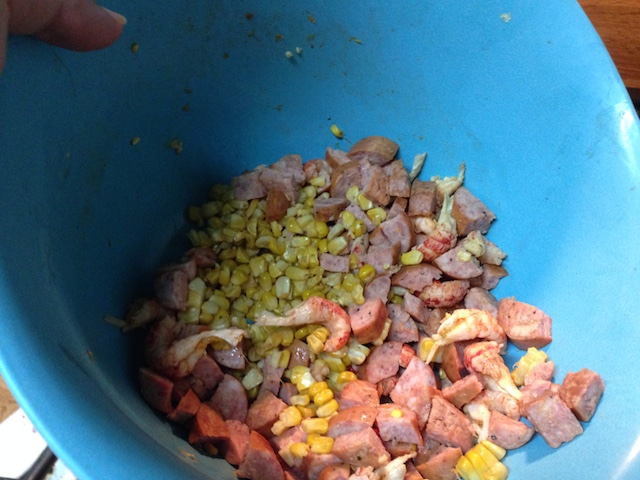
I didn’t have any okra for thickening the gumbo, so this left me with one major component of the dish yet to be made: the roux. Most of the recipes suggested a mixture of three cups flour to two cups oil for making roux. I decided to go with this amount.
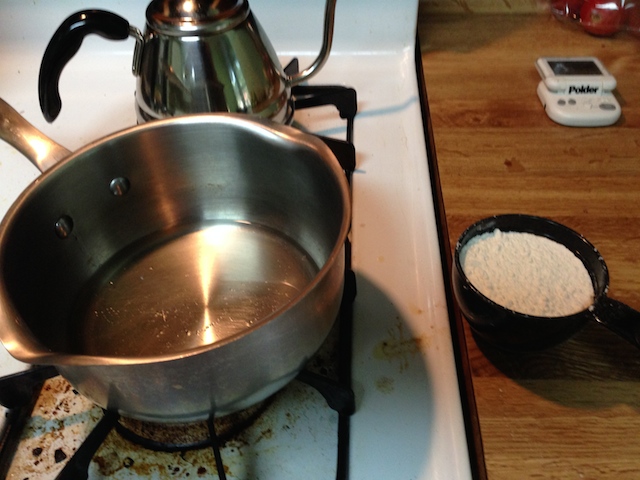
I worked fairly quickly and probably at a higher flame setting than most roux makers would recommend. I did however keep my spoon in the pot, stirring and scraping constantly to avoid scorching. Oil droplets frequently splattered on my shirt and arms as I stirred.
Due to camera, screen, and print differences, I’m not sure how close to “SW 6097 Sturdy Brown” I got. You be the judge.
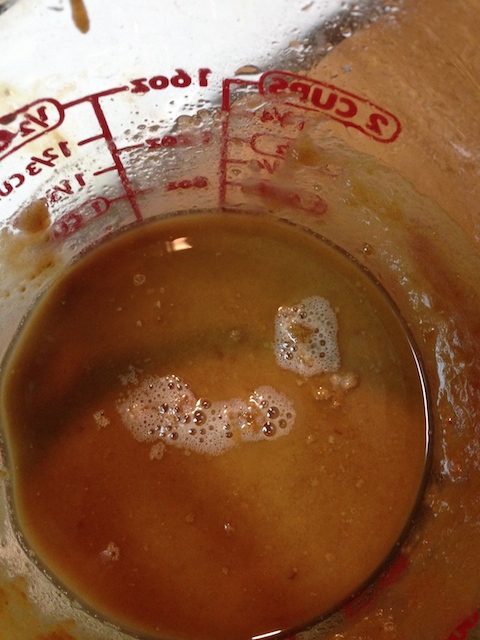
One area where I’m veering off-recipe is the fact that I’m making the roux separately, then adding it to the gumbo later. Most of the recipes I encountered had you preparing the roux in the stock pot, then cooking your Holy Trinity vegetables in the roux before adding water or stock. Since my stock pot was already being put to work, I decided to just make the roux separately and add it later.
Speaking of the stock pot, I was now ready to filter the stock and bring everything in for the finish. I turned off the heat, then removed all of the crawfish bodies and stock vegetables using a slotted spoon.
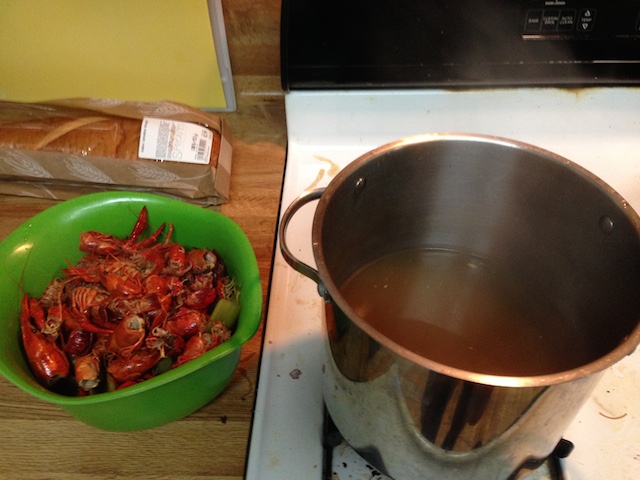
Now for the fun part: filtering all of the stock to get rid of any gritty nastiness and other foreign bodies. Frequently, recipes like this will recommend getting some cheesecloth to do the job. While that probably would have worked best, I didn’t have any cheesecloth. Instead, I wanted to see if an unconventional idea would work out.
I recently received a Chemex coffee maker as a gift, which comes with some very thick paper filters. My idea was to use one of the filters in a mesh sieve and then filter into another container.
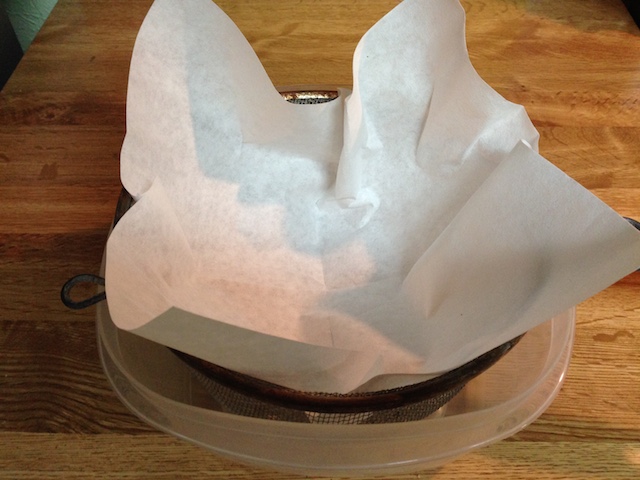
In went a bit of stock.
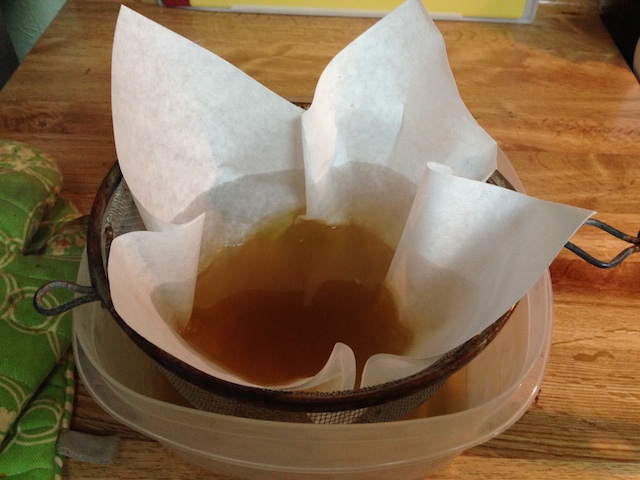
This was a slow, slow process. Chemex filters are designed to hold a lot of coffee grounds and near-boiling water, then drip your coffee in a fine stream. This was taking upwards of 10-15 minutes and it was getting closer to dinnertime, so I decided to shortcut the process a bit. I started fishing out some of the floating debris, then pouring the rest over the side being careful not to get any junk in the container.
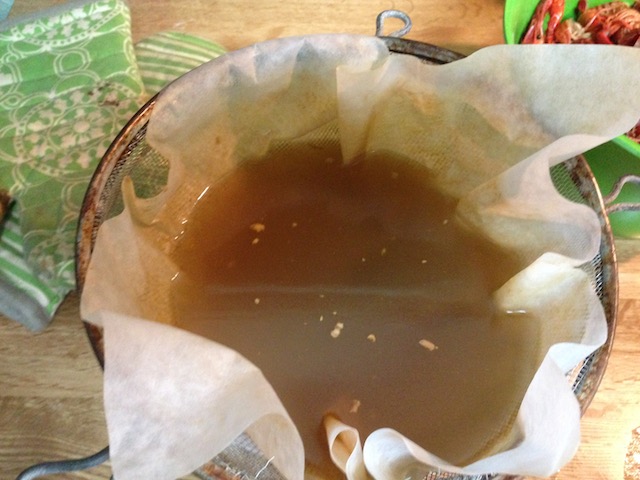
At the end of the process, my filter definitely looked used, but probably just as soon trapped flavors as much as it filtered undesirable things out.
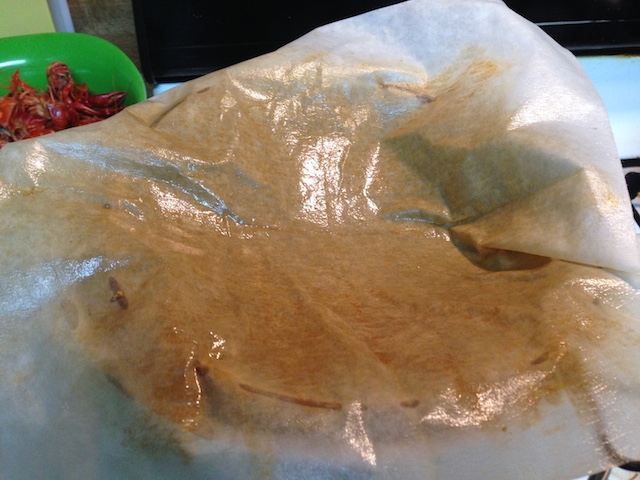
If I were to try this method again, I would probably forgo the thick Chemex filter. Instead, I’d grab one or two thinner coffee filters and then do a similar process.
(On the other hand, I could just buy cheesecloth. Oh well.)
With my stock mostly filtered, I’m now ready to put everything together and eat some gumbo. After cleaning the stock pot, I put in some of the roux and cooked some of the vegetables with it. I also put in the stock.

I then put in the rest of the vegetables. Some of the gumbo recipes I encountered suggested putting in diced tomatoes. I didn’t have any diced tomatoes, but I did have a small can of tomato paste. I debated about throwing the whole can in, but it seemed like that might be overkill. I so I put in about half of the can with the rest of the vegetables. This made the stock a little redder than I was anticipating. I got nervous.

Fortunately, I had some more roux, so I put in the rest of that to stand up to some of the tomato flavor. The redness died down as the tomato paste got incorporated and I breathed a sigh of relief. I skimmed off some of the fat and froth as it boiled to the top.
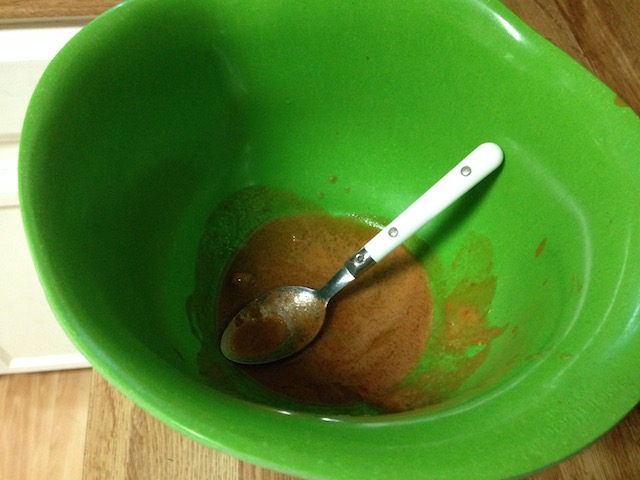
After simmering the gumbo and giving the flavors a chance to meld, I then added my meat, corn, parsley, and green onion. I left the gumbo on the heat just long enough to heat everything through.
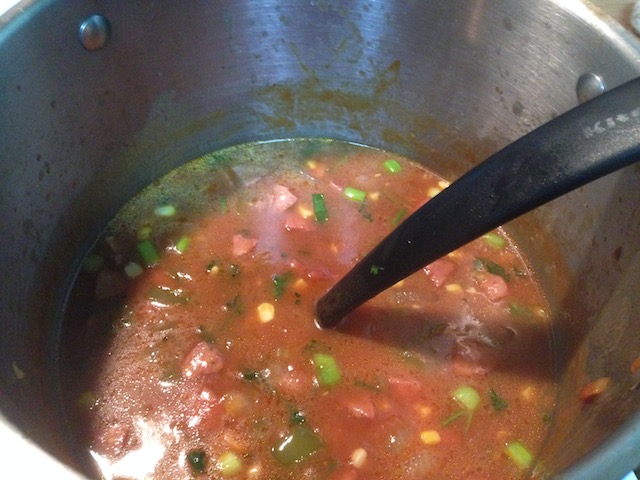
I then started putting a few servings into pint containers before putting the mushrooms in. After heating the mushrooms through, it was finally ready to eat.

While I was able to taste some tomato faintly, it wasn’t distracting. The spices from the crawfish boil came through and the roux did its job.
The gumbo was tasty, but there was one major omission from my dinner bowl: rice. It was hot out and my birthday weekend, so I decided to not bother with rice. I did have a loaf of French bread, so I sliced off some off that, since a dish like this is screaming to be round out with carbs of some sort.
If I didn’t make an authentic gumbo, I at least feel as though I did these leftover crawfish justice. I also now have some ideas of what I can do if I’m ever presented with a bag of leftover crawfish again.
-
For the record, crawfish omelets are indeed delicious and very much worth trying if you haven’t had them before. ↩